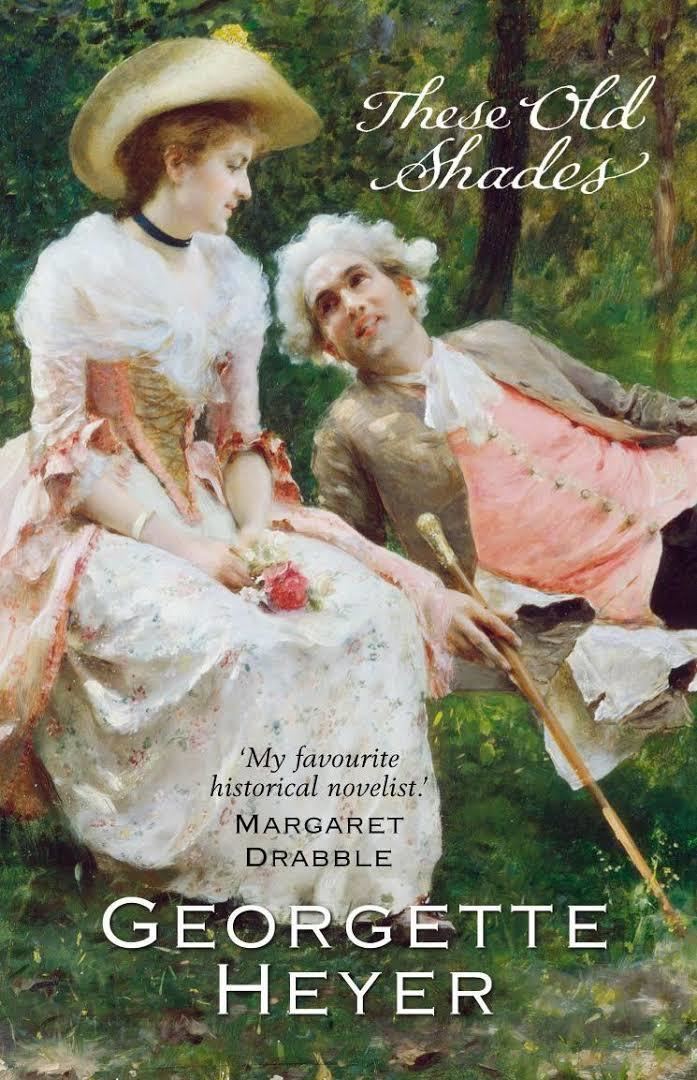8.2 /10 1 Votes8.2
4.2/5 Barnes & Noble Language English Pages 352 pp Followed by The Masqueraders | 4/5 Goodreads Country United Kingdom Publication date 1926 Originally published 1926 Preceded by Simon the Coldheart Publisher Heinemann | |||||||||||||||||||||||||||||||||
 | ||||||||||||||||||||||||||||||||||
Media type Print (hardback & paperback) Similar Georgette Heyer books, Romance novels | ||||||||||||||||||||||||||||||||||
These old shades by georgette heyer tableaux
These Old Shades (1926) is a Georgian (set around 1755–56) romance novel written by British novelist Georgette Heyer (1902–1974). It was an instant success, and established her as a writer. It falls into the category of historical romance.
Contents
Plot summary
Fortune favours Justin Alastair, the uncanny and notorious Duke of Avon, casting in his way, one Paris night, the means to revenge himself on his enemy, the Comte de Saint-Vire. Avon literally collides with an abused boy, Léon Bonnard, whose red hair, deep blue eyes and (improbably) black eyebrows proclaim him a child of the Comte.
Not knowing if the boy is a legitimate child or a "natural" (bastard) child, Avon purchases the boy from his brother, a tavern keeper. He takes the boy as his page, and Léon follows him to society's highest functions, and even goes to a Court party held by Louis XV, where he sees the king himself (who looks just like the coins, he says), views the Queen, and sees Madame de Pompadour. While at Versailles, the Duke displays Léon before the Comte's wife and his son and heir. He notes the resemblance of the son, Henri, to Léon's brother, Jean Bonnard, a tavern keeper. He also notes that the boy, Léon's age, prefers rural life, and wants to be a farmer. After this excursion to Versailles, the Comte sends one of his satellites to purchase the page, but Avon refuses. The Duke's friend, Hugh Davenant, tries to persuade Avon to give him the page; they both have realised, separately, that the boy Léon is actually the girl Léonie.
The Duke journeys into Champagne, where Léonie has grown up, to meet a childhood mentor, the village priest who educated her. This old man confirms to him that the Bonnard family came originally from the same province, indeed, from one of the estates, as the Comte de Saint-Vire. The Duke's desire for revenge soon turns to passion for justice as Léon – or rather, Léonie – has endeared herself to him. He takes her home to England and teaches her to be a girl again, under the name of Léonie de Bonnard. After an attempt to lure Léonie from Avon Court fails, the Comte kidnaps her and carries her to France. Léonie escapes from him with the help of the Duke's younger brother, Lord Rupert, and seeks refuge at an inn where Avon finds her and rescues her from a second attempt to abduct her. In the meantime, Fanny Marling, the Duke's sister, and her husband, join the party in France.
The Comte is forced to bide his time while Léonie makes her Parisian debut under the aegis of Lady Fanny. She becomes the toast of Paris, and the Comte and his wife watch helplessly, waiting for Avon to take his revenge. A rumour comes to Léonie's ears that she is the Comte's illegitimate child—the family likeness is very striking. When she confronts him with it, the Comte realises he has a chance to turn the tables on Avon. Admitting the rumour, the Comte tries to persuade Léonie he abducted her to save her. She does not believe him, but his threat to use her to harm Avon's reputation makes her agree to go away where no one will ever find her. She takes refuge with her old tutor, the priest in her home village.
Avon swiftly realises what the Comte has done. At a party with the Paris nobility watching, Avon tells her pathetic story as a fable and the Parisian high society, to their growing horror, realise the truth: that Léonie is indeed the Comte’s legitimate daughter and that she was switched at birth with a farm labourer’s son to prevent the Comte’s detested brother from inheriting the Comte’s title. Avon tells them how she suffered from the Comte’s actions and of his threat to use her to hurt the man she loves. Then, with a twist, he lets them believe that Léonie has drowned herself in the Seine.
This breaks her mother, whose open grief betrays the Comte's guilt. Knowing he is ruined in society, the Comte shoots himself. His despised brother becomes the new Comte.
With no difficulty, Avon traces Léonie to her childhood home in the country. She is glad her father is dead, but refuses to go back to her life in Paris. She doesn’t want her family back – she wants Avon, but he knows his tainted reputation makes him unworthy of her. She doesn’t care.
Avon returns to Paris in triumph to present his new duchess, Léonie.
Devil's Cub follows These Old Shades with the adventures of Avon's and Léonie's son Dominic, a shockingly selfish and indulged young man who elopes with a poor relation of one of his father's friends. An Infamous Army completes the story with the Duke of Avon's great-granddaughter, Barbara, marrying the hero of An Infamous Army. An Infamous Army is also a sequel to Regency Buck.
Sequel
These Old Shades was itself originally intended to be a sequel to Heyer's first novel The Black Moth, which would redeem the devilish Belmanoir. But as The Black Moth was a melodrama and a sequel per se would not work in with the plot, she decided to make the new novel stand alone, renamed many characters and made them 'shades' of their former selves for These Old Shades.
